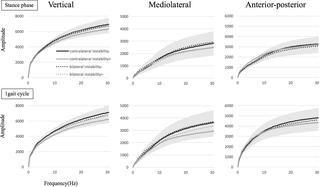PLOS ONE ( IF 2.9 ) Pub Date : 2018-03-16 , DOI: 10.1371/journal.pone.0194221 Tatsuya Soeno 1 , Tomoharu Mochizuki 1 , Osamu Tanifuji 1 , Hiroshi Koga 1 , Takayuki Murayama 2 , Hiroki Hijikata 1 , Yuki Takahashi 2 , Naoto Endo 1

|
Introduction
Instability after total knee arthroplasty is a critical problem. The purpose of this study was to clarify the stability of implanted knees during walking by comparing differences in dynamic instability during knee acceleration between individuals with or without previously experienced subjective instability, as measured by self-reported questionnaire.
Materials and methods
We examined 92 knees with medial pivot implants. Mean patient age and follow-up duration were 78.4 years and 32.8 months, respectively. An accelerometer was used to investigate the accelerations along three axes; that is, vertical (VT), mediolateral (ML), and anteroposterior (AP) directions in 3-dimensional (3D) space. The analysis in the stance phase and gait cycle was performed by: (1) root mean square (RMS) values of acceleration and (2) frequency domain analysis using fast Fourier transformation (FFT). A self-reported knee instability score was used for the subjective feeling of instability.
Results
A total of 76 knees did not feel unstable (group 0), but 16 knees felt unstable (group 1) in patients during activities of daily living. Regarding the RMS, there were no differences in each direction between the groups. For FFT, the cumulative amplitude in the frequency < 30 Hz also showed no significant differences in all directions between the groups during the stance phase (VT, p = 0.335; ML, p = 0.219; AP, p = 0.523) or gait cycle (VT, p = 0.077; ML, p = 0.082; AP, p = 0.499).
Discussion
Gait analysis based on the acceleration data showed that there were no between-group differences in objective dynamic instability during acceleration of the knee, with or without reports of previously experienced subjective instability, as assessed by the self-reported questionnaire.
中文翻译:

在全膝关节置换术后有或没有主观不稳定性的情况下,膝关节加速过程中客观动态不稳定性没有差异
介绍
全膝关节置换术后的不稳定是一个关键问题。本研究的目的是通过比较以前经历过或没有经历过主观不稳定性的个体在膝关节加速过程中动态不稳定性的差异(通过自我报告的问卷测量)来阐明行走过程中植入膝关节的稳定性。
材料和方法
我们检查了 92 个带有内侧枢轴植入物的膝盖。患者平均年龄和随访持续时间分别为 78.4 岁和 32.8 个月。使用加速度计来研究沿三个轴的加速度;即 3 维 (3D) 空间中的垂直 (VT)、内侧 (ML) 和前后 (AP) 方向。站立阶段和步态周期的分析通过以下方式进行:(1)加速度的均方根(RMS)值和(2)使用快速傅立叶变换(FFT)的频域分析。自我报告的膝关节不稳定评分用于主观不稳定感觉。
结果
共有 76 个膝关节没有感觉不稳定(第 0 组),但有 16 个膝关节在日常生活活动中感觉不稳定(第 1 组)。关于 RMS,各组之间在每个方向上没有差异。对于 FFT,在站立阶段(VT, p = 0.335;ML, p = 0.219;AP, p = 0.523)或步态周期( VT, p = 0.077;ML, p = 0.082;AP, p = 0.499)。
讨论
基于加速度数据的步态分析表明,根据自我报告的问卷评估,无论有或没有先前经历过的主观不稳定的报告,膝关节加速期间的客观动态不稳定性没有组间差异。







































 京公网安备 11010802027423号
京公网安备 11010802027423号